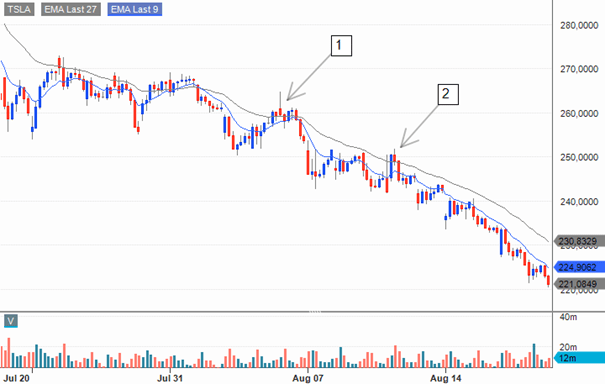Trends and feints

Traders with a technical and quantitative approach to the market often spend a lot of time looking for trends and trend changes with the aim of using these for position taking. If you show a chart to anyone, most people will be able to see some wave movements and point to the areas that would provide ideal entry and exit positions. However, this is a historical picture, and there it is always easy to see what should have been done. A chart in itself does not predict the future but shows what has been the path up to the present time.
Testing and confirming the trend
It is important to occasionally remind yourself of what a market is. It is a place for the trading of goods or securities, and prices will, as if guided by a force of nature, move to where the largest volume can be traded. This is simply the price at which most sellers and buyers can agree that a trade should take place. In the securities market, trading is mainly done electronically, so you can observe the pricing process in real time. Long-term investors, strategic owners, insiders, asset managers, short-term traders, small savers, market makers, and trading robots are all present. Some trade positions they intend to hold for weeks and months, while at the other end there are players who measure their time horizon in seconds and minutes. Most active traders tend to be somewhere in the middle, focusing on movements that go from intraday to lasting a few days. The actions of everyone will affect the price, and it is against this background that trends arise.
A trend can be described as a continuous price movement in one direction. Upward, downward, or sideways, though some refer to the last one as a consolidation.
You could write a whole book about price formation and trends, and many have. In this blog post, I want to highlight a topic that is rarely described, and which I myself work on to improve in my own trading. These are the "feints" you are often exposed to when dealing with active positions within the trends.
There are many trading strategies that are based on trends. For example, you can make trend-trades in the same direction as the current trend, countertrend trades in the opposite direction, look for breaks in the trends (breakouts) or position yourself for movements back towards the middle of the trend (mean reversion). All of these strategies are valid, and there are traders who only specialize in one or two. Ideally, however, one should have several strategies in one's arsenal, and alternately use those that best suit the current climate in the market. However, this is easier said than done. In any case, it is important to know exactly which strategy you choose to trade, and thus what to look for. Strategies that work well under certain types of market conditions may work very poorly under others. The clearest contrast is found between the strategies trend-trades and breakouts. This is also a good example of what I mean by "feint" in trends, and it is illustrated in the example below.

The price chart above shows 1-hour candlesticks in Tesla from the end of July until August 2023. Each bar (candle) thus corresponds to 1 hour of price movements. In retrospect, you see a very clear downward trend, but experiencing this in real time is not as easy. Let's focus on the point labeled 1. (number 2 is a similar but not as clear example.) The red candlestick with a high tail to which the arrow is pointing is the opening hour for TSLA on Friday, August 4th. As we can see, the stock had dipped below a technical support level two days prior but reversed and closed strongly with breaches of the 9 and 27 hour moving averages the day before August 4. The share thus showed possible strength and would have been a candidate for a "breakout" trade if the strength continued the following day. It also did so in the first minutes after opening. In a more positive (bullish) market climate, such trades can work very well, and are typically something both traders and stockbrokers are looking for. In point 1, however, the high tail/wick on the candlestick illustrates that the attempted breakout reversed during the first hour. The stock then went sideways for the next 4 hours before breaking back down through the aforementioned moving averages and continuing the downtrend from the prior days.
In retrospect, this reversal after attempting a breakout appears to be the exact ideal time to put a new short for a trader who wants to position himself for a continuation of the downtrend. The point marked with 2 is a similar case. The current downtrend has lasted for some time, and initial strength may illustrate that the stock is ready for an upward breakout. In both cases, the share also shows a trend break, but to see this quickly reversed. The failed break thus becomes confirmation that the downtrend is intact, and new shorts can be set.
However, handling this ideally is not easy for a trader. If you have envisioned a breakout, you would also like to see confirmation of strength before starting a long position by buying the share. The initial move up will show this, and many traders will do their buying there. Perhaps they will then hit the spire in the stock right away and go into stop-loss a couple of dollars lower before they have time to think. I have experienced this many times. You then get a small loss and sit and watch while what would have been a great trend trade from the short side plays out. I personally believe that the key to acting better in such cases is to have a clear plan A and plan B defined in advance. When looking for possible tipping points in the stock, this is often smart. If scenario A plays out, you will get a good entry on a long, while if scenario B strikes, you will have a good entry on a short. In both cases, you have clear stop-loss levels to set based on the share's history. But you have to be very quick when the momentum shift in the stock happens. It's not easy to have two such mutually exclusive scenarios in your head at the same time, but with practice it should be possible.
I would add that the example above with 1-hour candlesticks is suitable for intraday trading, or relatively short-term swing trading over a few days. However, such chart movements repeat themselves in all time periods, so similar setups can be looked for on both daily and weekly charts, as well as on shorter intraday horizons.
Risks
External author:
This information is in the sole responsibility of the guest author and does not necessarily represent the opinion of Bank Vontobel Europe AG or any other company of the Vontobel Group. The further development of the index or a company as well as its share price depends on a large number of company-, group- and sector-specific as well as economic factors. When forming his investment decision, each investor must take into account the risk of price losses. Please note that investing in these products will not generate ongoing income.
The products are not capital protected, in the worst case a total loss of the invested capital is possible. In the event of insolvency of the issuer and the guarantor, the investor bears the risk of a total loss of his investment. In any case, investors should note that past performance and / or analysts' opinions are no adequate indicator of future performance. The performance of the underlyings depends on a variety of economic, entrepreneurial and political factors that should be taken into account in the formation of a market expectation.
Disclaimer:
This information is neither an investment advice nor an investment or investment strategy recommendation, but advertisement. The complete information on the trading products (securities) mentioned herein, in particular the structure and risks associated with an investment, are described in the base prospectus, together with any supplements, as well as the final terms. The base prospectus and final terms constitute the solely binding sales documents for the securities and are available under the product links. It is recommended that potential investors read these documents before making any investment decision. The documents and the key information document are published on the website of the issuer, Vontobel Financial Products GmbH, Bockenheimer Landstrasse 24, 60323 Frankfurt am Main, Germany, on prospectus.vontobel.com and are available from the issuer free of charge. The approval of the prospectus should not be understood as an endorsement of the securities. The securities are products that are not simple and may be difficult to understand. This information includes or relates to figures of past performance. Past performance is not a reliable indicator of future performance.
© Bank Vontobel Europe AG and/or its affiliates. All rights reserved.
